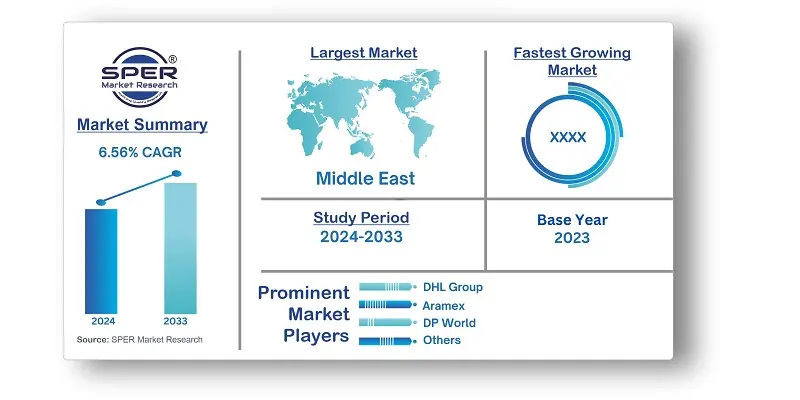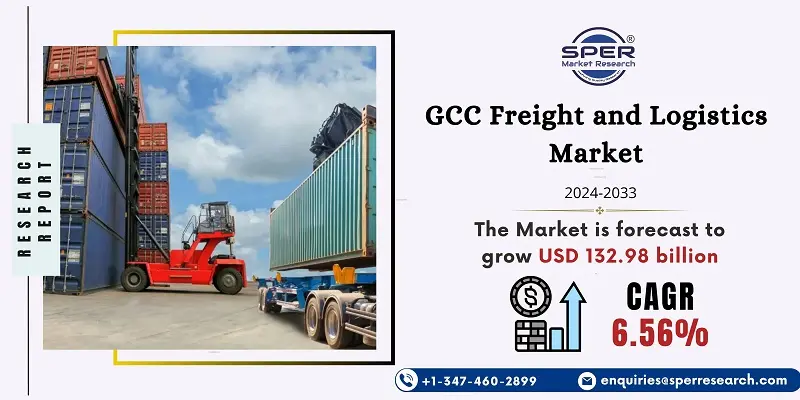
GCC Freight and Logistics Market Trends, Share, Size, Revenue, Competition and Future Outlook
GCC Freight and Logistics Market Growth, Size, Trend Analysis- By End User Industry, By Logistics Function- Regional Outlook, Competitive Strategies and Segment Forecast to 2033
| Published: Nov-2024 | Report ID: AMIN24245 | Pages: 1 - 159 | Formats*: |
| Category : Automotive & Transportation | |||
- March 2024: With the opening of a new regional office in Riyadh, Aramex has increased its footprint in Saudi Arabia. This will help the company better serve both new and existing companies in the region, improve the Kingdom's logistics infrastructure, and help achieve Vision 2030's objective of making Saudi Arabia a global logistics hub.
- January 2024: To further its decarbonisation solutions, Kuehne + Nagel has unveiled its Book & Claim insetting solution for electric vehicles. For Kuehne + Nagel, creating Book & Claim insetting systems for road freight was a top strategic objective. When it is not feasible to physically deliver their goods on electric trucks, customers that utilise Kuehne + Nagel's road transport services can now claim the carbon reductions of these vehicles.


| Report Metric | Details |
| Market size available for years | 2020-2033 |
| Base year considered | 2023 |
| Forecast period | 2024-2033 |
| Segments covered | By End User Industry, By Logistics Function. |
| Regions covered | Qatar, Saudi Arabia, UAE, Rest of GCC. |
| Companies Covered | Al Madina Logistics, Al-Futtaim Logistics, Almajdouie, Aramex, Asyad, Bahri, DB Schenker, DHL Group, DP World, Others. |
- Retailers
- Manufacturers
- E-commerce companies
- FMCG companies
- Third-party logistics (3PL) providers
- Government agencies
- Construction companies
- Oil and gas companies
- Automotive companies
- Healthcare and pharmaceutical companies
| By End User Industry: | |
| By Logistics Function: |
- GCC Freight and Logistics Market Size (FY’2024-FY’2033)
- Overview of GCC Freight and Logistics Market
- Segmentation of GCC Freight and Logistics Market by End User Industry (Agriculture, Fishing and Forestry, Construction, Manufacturing, Oil and Gas, Mining and Quarrying, Wholesale and Retail Trade, Others)
- Segmentation of GCC Freight and Logistics Market by Logistics Function (Courier, Express and Parcel, Freight Forwarding, Freight Transport, Warehousing and Storage, Other Services)
- Statistical Snap of GCC Freight and Logistics Market
- Expansion Analysis of GCC Freight and Logistics Market
- Problems and Obstacles in GCC Freight and Logistics Market
- Competitive Landscape GCC Freight and Logistics Market
- Impact of COVID-19 and Demonetization GCC Freight and Logistics Market
- Details on Current Investment in GCC Freight and Logistics Market
- Competitive Analysis of GCC Freight and Logistics Market
- Prominent Players in the GCC Freight and Logistics Market
- SWOT Analysis of Germany Haying and Forage Machinery Market
- GCC Freight and Logistics Market Future Outlook and Projections (FY’2024-FY’2033)
- Recommendations from Analyst
1.1. Scope of the report1.2. Market segment analysis
2.1. Research data source
2.1.1. Secondary Data2.1.2. Primary Data2.1.3. SPERs internal database2.1.4. Premium insight from KOLs
2.2. Market size estimation
2.2.1. Top-down and Bottom-up approach
2.3. Data triangulation
4.1. Driver, Restraint, Opportunity and Challenges analysis
4.1.1. Drivers4.1.2. Restraints4.1.3. Opportunities4.1.4. Challenges
4.2. COVID-19 Impacts of the GCC Freight and Logistics Market.
5.1. SWOT Analysis
5.1.1. Strengths5.1.2. Weaknesses5.1.3. Opportunities5.1.4. Threats
5.2. PESTEL Analysis
5.2.1. Political Landscape5.2.2. Economic Landscape5.2.3. Social Landscape5.2.4. Technological Landscape5.2.5. Environmental Landscape5.2.6. Legal Landscape
5.3. PORTERs Five Forces
5.3.1. Bargaining power of suppliers5.3.2. Bargaining power of buyers5.3.3. Threat of Substitute5.3.4. Threat of new entrant5.3.5. Competitive rivalry
5.4. Heat Map Analysis
6.1. GCC Freight and Logistics Market Manufacturing Base Distribution, Sales Area, Product Type6.2. Mergers & Acquisitions, Partnerships, Product Launch, and Collaboration in GCC Freight and Logistics Market
7.1. GCC Freight and Logistics Market Size, Share and Forecast, By End User Industry, 2020-20267.2. GCC Freight and Logistics Market Size, Share and Forecast, By End User Industry, 2027-20337.3. Agriculture, Fishing and Forestry7.4. Construction7.5. Manufacturing7.6. Oil and Gas, Mining and Quarrying7.7. Wholesale and Retail Trade7.8. Others
8.1. GCC Freight and Logistics Market Size, Share and Forecast, By Logistics Function, 2020-20268.2. GCC Freight and Logistics Market Size, Share and Forecast, By Logistics Function, 2027-20338.3. Courier, Express and Parcel8.4. Freight Forwarding8.5. Freight Transport8.6. Warehousing and Storage8.7. Other Services
9.1. GCC Freight and Logistics Market Size and Market Share
10.1. GCC Freight and Logistics Market Size and Market Share By Region (2020-2026)10.2. GCC Freight and Logistics Market Size and Market Share By Region (2027-2033)10.3. Qatar10.4. Saudi Arabia10.5. UAE10.6. Rest of GCC
11.1. Al Madina Logistics
11.1.1. Company details11.1.2. Financial outlook11.1.3. Product summary11.1.4. Recent developments
11.2. Al-Futtaim Logistics
11.2.1. Company details11.2.2. Financial outlook11.2.3. Product summary11.2.4. Recent developments
11.3. Almajdouie
11.3.1. Company details11.3.2. Financial outlook11.3.3. Product summary11.3.4. Recent developments
11.4. Aramex
11.4.1. Company details11.4.2. Financial outlook11.4.3. Product summary11.4.4. Recent developments
11.5. Asyad
11.5.1. Company details11.5.2. Financial outlook11.5.3. Product summary11.5.4. Recent developments
11.6. Bahri
11.6.1. Company details11.6.2. Financial outlook11.6.3. Product summary11.6.4. Recent developments
11.7. DB Schenker
11.7.1. Company details11.7.2. Financial outlook11.7.3. Product summary11.7.4. Recent developments
11.8. DHL Group
11.8.1. Company details11.8.2. Financial outlook11.8.3. Product summary11.8.4. Recent developments
11.9. DP World
11.9.1. Company details11.9.2. Financial outlook11.9.3. Product summary11.9.4. Recent developments
11.10. Others
SPER Market Research’s methodology uses great emphasis on primary research to ensure that the market intelligence insights are up to date, reliable and accurate. Primary interviews are done with players involved in each phase of a supply chain to analyze the market forecasting. The secondary research method is used to help you fully understand how the future markets and the spending patterns look likes.
The report is based on in-depth qualitative and quantitative analysis of the Product Market. The quantitative analysis involves the application of various projection and sampling techniques. The qualitative analysis involves primary interviews, surveys, and vendor briefings. The data gathered as a result of these processes are validated through experts opinion. Our research methodology entails an ideal mixture of primary and secondary initiatives.



Frequently Asked Questions About This Report
PLACE AN ORDER
Year End Discount
Sample Report
Pre-Purchase Inquiry
NEED CUSTOMIZATION?
Request CustomizationCALL OR EMAIL US
100% Secure Payment






Related Reports
Our Global Clients
Our data-driven insights have influenced the strategy of 200+ reputed companies across the globe.






















